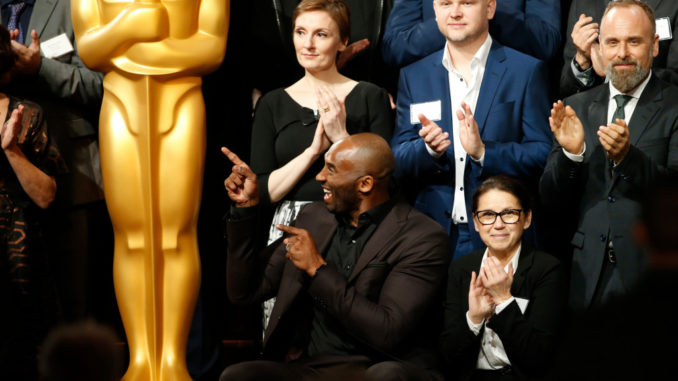
In this burgeoning business of storytelling, and taking the most credit for the ability to cut and paste ideas, the NBA knows a good one when it can tell it in its own ways. And just because it has a certain height advantage here, there are no tall tales evident of a pro league boasting it has this whole media business figured out.
As celebrated as its All-Star Weekend arrival in Los Angeles will be documented, capped off by Sunday’s exhibition game at Staples Center, there may have been an even bigger star-studded NBA Tech Summit at the Beverly Hilton last Friday morning. It punctuated just how influential the league’s basic knowledge and implementation has become of the current media landscape connects players and teams to its fanbase.
Now it’s willing to share. Or drop a a handful of dimes, in basketball parlance.
In a power-meeting ballroom more often shown off during Golden Globe presentations, here was the meshing of Clippers owner Steve Ballmer’s vision of artificial intelligence with an global strategy executive from Facebook trying to disprove a Silicon Valley myth about millennial short attention spans, relating a story about how viewers’ input resulted in reordering longer episodes of the “Ball in the Family” reality show.
All of it was off the record – with some irony the NBA apparently doesn’t care to acknowledge. Even some mass media distribution has its limits and could dilute the perception of unfiltered truth speaking.
But Connor Schell, ESPN’s award-winning documentarian recently promoted to executive vice president of content and on a panel led by TNT’s Ernie Johnson that did a deeper dive into the art of storytelling with today’s techno gadgetry, was able to explain more of his take-away from how the NBA is telling – and selling – its own narrative at this season’s intermission.
In this particularly appropriate city, and at this exact moment, it can’t be undervalued as a template to reinforce for others to admire and apply to its own game plans.
“We talk about the elements of every story you tell – inform, entertain and surprise, and nothing surprises people like live sports, because no one knows the ending, so that becomes the greatest vehicle for story telling in the world,” said Schell in the hotel lobby afterward.
“Sports creates heroes and villains and sympathetic characters and all this drama and triumphs and sadness – it’s all the elements of a great Hollywood story, or a documentary, plays out on the court literally every day.
“And the NBA and its players have been successful in adding to that a real-time access and conversation. There is seemingly as interesting off the court as on the court and they’ve done that really well. Ultimately all that leads to greater connection with their fans and more interest in the game.”
A MULTI-PLATFORM PERFORMANCE
If this storytelling thesis wasn’t working, the good old TV ratings might reflect it. But in the NBA, that’s another story it enjoys framing positively.
The Sports Business Daily reported that NBA regular season games to date over ABC, ESPN and TNT are up 15 percent from last year through the All-Star break. TNT leads the way with a 20 percent jump (1.9 million viewers through 44 telecasts). Broken down by demographics, women’s influence on the numbers is more impressive than the men’s.
Games on regional networks are up 9 percent. The Clippers’ games on Prime Ticket have seen an 88 percent jump in the adult 18-to-34 age demographic through 54 games this far, according to Nielsen sources. Lakers’ games on Spectum SportsNet are up 22 percent compared to the 2016/17 final average. The pregame shows are also up 30 percent, and postgame has jumped 38 percent.
On social media, TNT and NBA TV is up 10 percent over a year ago, with nearly 3.1 billion social impressions on Facebook and Twitter since Opening Night. Video views on those accounts are up 47 percent.
How does the NBA buck an annoying trend that the NFL constantly tries to dismiss with a variety of excuses?
Sure, the players don’t wear face-covering helmets or caps, might be a bit more expressive in an intimate visual setting, and on-going social media banter amongst star player feed into a unique fan connection.
(One subliminal secret revealed from the Hilton ballroom: NBA commissioner Adam Silver pointed out that a 94-by-50 basketball court has the same visual ratio as a movie screen or flat-screen TV. Coincidence?)
Schell was more blown away by how ratings took off recently for its NBA studio show, “The Jump,” on trade day, during a 90-minute special fueled by breaking news provided in Twitter by its own new media star, Adrian Wojnarowski.
“It was unbelievable engagement,” said Schell. “That’s the element of surprise again. You literally can’t write that.”
MADE IN AMERICA MEDIA MOGELS
So there was Miami Heat star Dwayne Wade, hosting an exclusive screening of a documentary, “Shot in the Dark,” at Pacific Design Center in West Hollywood on Thursday night. The film about the lives of NBA prospects dealing with gang violence and poverty in Chicago comes directly from a media company Wade has an executive producer role with: Chance the Rapper. Fox premieres the show Saturday. Video-on-demand Cheddar.com was all over reporting on it.
Count that toward the other part of this baller equation: Players taking the media into their own hands. And we’re not just talking about The Players Tribune, which Kobe Bryant’s media company has helped finance.
Bryant,the retired Lakers star building momentum with his Academy Award-nominated animated documentary based on his multi-media “Dear Basketball” project, can talk a whole new courtship language with current NBA star Kevin Durant, whose Thirty Five Media company created last April is in production with producer Brian Grazer on a drama called “Swagger,” based on Durant’s incredibly documented life.
You likely already are aware of the plethora of L.A.-based media projects LeBron James is involved with, which led to him buying a Brentwood home and fueling talk of him playing for the Lakers or Clippers as soon as next season to consolidate his business ventures.
A comedy titled “Uncle Drew,” starring Boston guard Kyrie Irving and others, will be in theatres this summer at a time when sports movies aren’t all that abundant any more.
That’s how they’re drawing this up.
If players viewed an ESPN or TNT as simply a middle man in the media delivery process, they are unapologetically taking their story into their own hands and portfolios.
So how does a media giant like ESPN stay relevant without being looked upon as “the old way” of doing things?
“Yes, Aaron Rodgers can tweet and we can post on Instagram his own story in his own certain way, but then (ESPN writer and TV personality) Mina Kimes can bring him to life in a way only a great writer can,” said Schell. “Some of bringing an athlete’s story to life is reacting, some of it is giving them a platform, and some of it is laying a level of authenticity or persuasiveness or authority on top of that. We aspire to be a platform for the best story tellers in the world, with all our talent and producers.
“I still believe quality wins in a world of infinite choice, and that’s the bar we’re trying to get to every day.”
The paradigm shift also continues to no longer emphasize creating a seven-minute piece for an “E:60” or parceling out a three-part, 50-minute window for an ESPN documentary, Schell added. Stories aren’t limited by length or platform, but are delivered more by what tells it best.
“It’s really with the strategy and goal to think ‘story first’ — this is to me the important point,” said Schell, part of the executive team that created the “O.J.: Made in America” multi-part documentary for both TV and movie theatres that received an Academy Award for its quality and depth of work.
“The ways fans interact with social feeds, apps, websites, our networks, it’s completely unshackled from traditional formats. And I think that’s a unique place we get to exist in today because we’re reaching all these people on all these different mediums.
“Instead of ‘you have to fill X-number of column inches each day,’ we think of how to bring a story to life in the best possible form, and if variations of that story work across other platforms, you tell it differently. That’s what we aspire to do.”
And that’s the story Schell is sticking to here.
MEASURING MEDIA MAYHEM
WHAT SMOKES
== The Beverly Hilton ballroom has more sports cred – it was the host venue again for the 13th annual L.A. Sports Council’s Awards Show, hosted by Patrick O’Neal and recorded by Fox Sports West to air as a 90-minute program starting Monday at 8:30 p.m. with various replays.
== At the urging of former sportscaster-turned-stage-performer Roy Firestone, Kareem Abdul-Jabbar told the Associated Press last week he plans to start a cross-country audience-interactive stage production this fall called “Becoming Kareem,” a title that comes from his 2017 young-adult autobiography (already listed on Amazon as No. 1 in Children’s Islam Books category). It’s the latest attempt by the 70-year-old Basketball Hall of Famer with UCLA and Lakers pedigree to reconstruct his media image that was often sullied by his own doing with the way he often handled himself with reporters during his playing days. “And that was very unfortunate,” Abdul-Jabbar told an AP reporter from his Newport Beach foundation office. “I think it kept me from a head coaching job and commercials and stuff because people wanted to assume the worst.” As long as Kareem can handle whatever the drama critics’ review of his stage show might be, he should hook enough patrons who will be engaged with the thought-provoking conversationalist. Warning: This could inspire Bill Walton to follow this same path.
WHAT CHOKES
If not called out by the Boston Globe, which led to a sponsor revolt, one is left to wonder if Boston sports-talk radio station WEEI would not have gone to the extreme to finally suspending live programming Friday to hold an 12-hour mandatory sensitivity training meeting for its employees (particularly on-air talent) in the wake of ridiculous incidents and suspensions that did nothing to improve the company’s credibility or the genre’s overall purpose. Shirley Leung, a Globe columnist and self-defined Chinese America mother of two, urged the Red Sox and Patriots to speak up as broadcast partners and advertisers to withhold their spending. It happened. “WEEI hosts are entitled to free speech,” Leung wrote, “and so are their listeners, but the station routinely crosses a line that makes Boston a hostile place to live. Tune them out? No, we need to stop the vitriol.” After the sensitivity training was announced, Leung followed up: “Let’s hope they finally get it.” If they do, they’ll be making more sports radio history.





